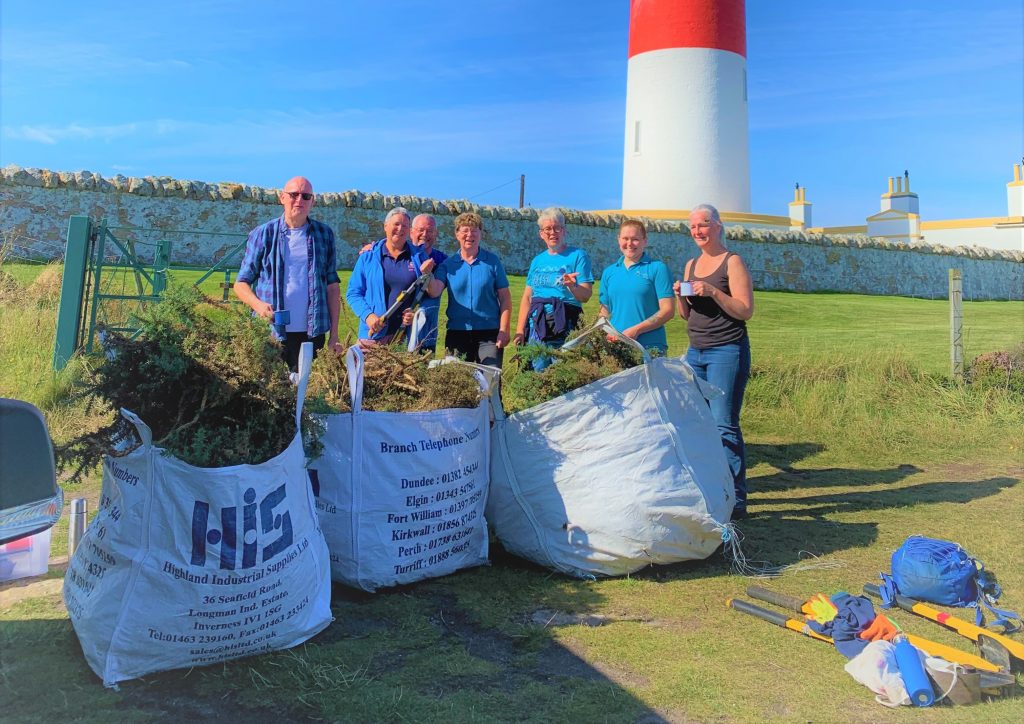
High Life Highland’s Countryside Rangers observed that the valuable coastal heath habitat at Tarbat Ness was in danger of being crowded out by encroaching Gorse.
In response, a Gorse-clearing event was hosted in the area by High Life Highland’s Countryside Rangers on Saturday 2nd September, inviting volunteers from the community to lend a helping hand in the process.
From 10am to 12pm, High Life Highland’s Countryside Rangers and volunteers used hand tools and protective gloves to remove Gorse closest to the paths, to give important Heath vegetation underneath a chance to grow.
Marcia Rae, High Life Highland’s Countryside Ranger for the Easter Ross area, shared: “The Gorse-clearing event went really well, and we were able to achieve a lot in only two hours.
“Overall, there were six volunteers as well as help from Tracy Munro, who works for Butterfly Conservation on the ‘Species on the Edge’ project. We cleared a lot of Gorse from the edges of the paths to make access easier, and also removed Gorse overhanging and shading out the maritime heath.
“Tarbat Ness is designated a ‘Site of Special Scientific Interest’ because of the maritime heath habitat there, so we want to stop the gorse from taking over. In total, we managed to fill three very large builders’ bags to the brim with Gorse cuttings!
“After a short break, Tracy led the planting out of roughly twenty ‘Kidney Vetch’ plants on a different part of the site. Some of these plants were grown for the Countryside Rangers team at the local school: Hill of Fearn Primary.
“It was an insightful, rewarding day out in nature, consisting of spectacular community and teamworking efforts. The hope of clearing Gorse and planting Kidney Vetch is to expand the numbers of Small Blue Butterflies, which are a vulnerable species at Tarbat Ness.”
Tracy Munro, High Life Highland’s East Coast Scotland Project Manager for the ‘Species on the Edge’ programme, added: “The East Coast Species on the Edge team were thrilled to work alongside High Life Highland Countryside Rangers and members of the public at Tarbat Ness.
“The site is an ideal location to demonstrate how partnership working can improve the habitat for the Small Blue (Cupido minimus) butterfly, as well as being an ideal opportunity to introduce the public to their local butterfly populations.
“The tiny but mighty Small Blue is the UKs smallest butterfly and has undergone a rapid decline in Scotland in recent years. The caterpillar’s sole foodplant, Kidney Vetch, grows profusely at Tarbat Ness and is at risk of being shaded out by the gorse.
“Working through the ‘Species on the Edge’ programme, Butterfly Conservation is working closely with partners to reverse the decline in fortunes of this iconic species. We hope to hold further work parties with High Life Highland’s Countryside Rangers services in early Spring – and come May, when the butterfly is on the wing, the ‘Species on the Edge’ team will lead some butterfly walks around the area.”
Steve Walsh, High Life Highland’s Chief Executive, concluded: “High Life Highland is delighted to be working with local volunteers to preserve nature in key areas such as Tarbat Ness.
“High Life Highland’s Countryside Rangers work tirelessly to ensure that Highland areas of natural wildlife is maintained with care, the impacts of which can be demonstrated through projects such as ‘Species on the Edge’ and ‘Wildflower Meadow Mosaic’.”
For anyone keen to get involved in the ‘Species on the Edge’ programme, please contact Tracy Munro: [email protected]
For more information about upcoming High Life Highland Countryside Ranger events, please contact Marcia Rae on [email protected] or visit the following dedicated webpage: https://www.highlifehighland.com/rangers/


